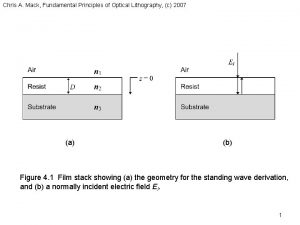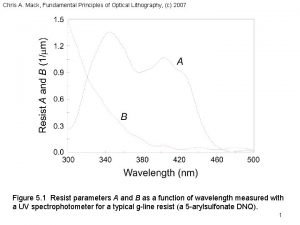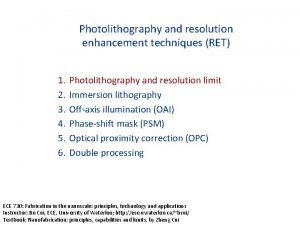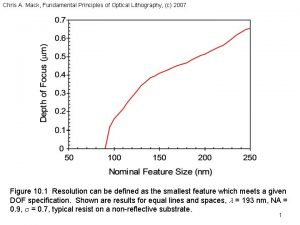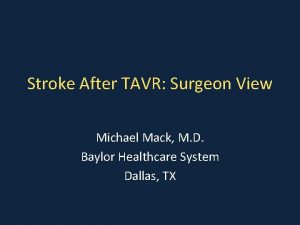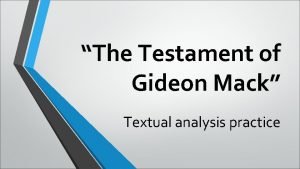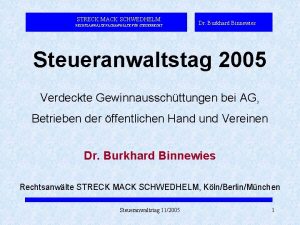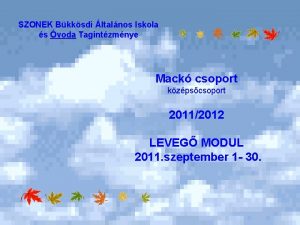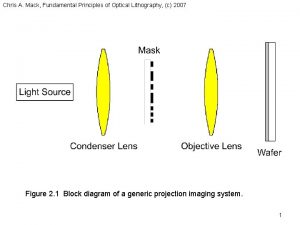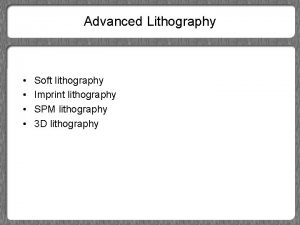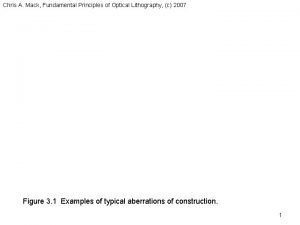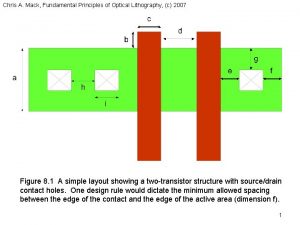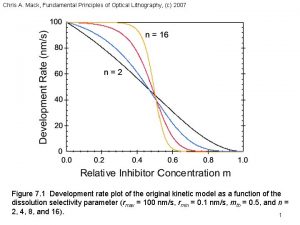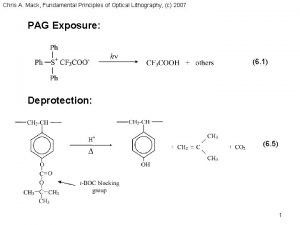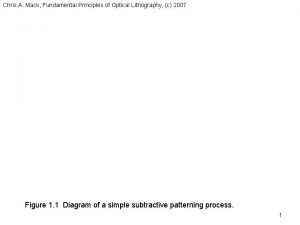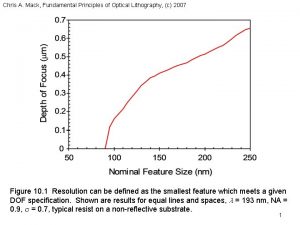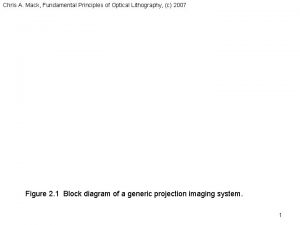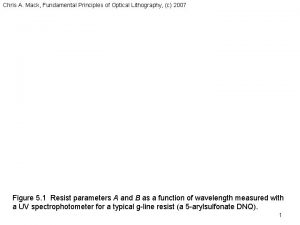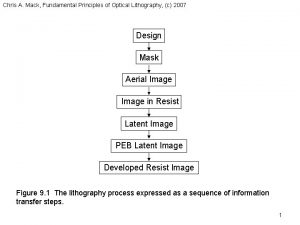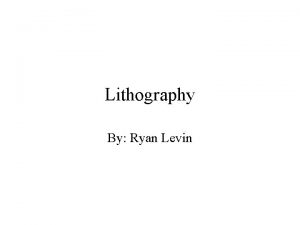Chris A Mack Fundamental Principles of Optical Lithography















- Slides: 15

Chris A. Mack, Fundamental Principles of Optical Lithography, (c) 2007 Figure 5. 1 Resist parameters A and B as a function of wavelength measured with a UV spectrophotometer for a typical g-line resist (a 5 -arylsulfonate DNQ). 1

Chris A. Mack, Fundamental Principles of Optical Lithography, (c) 2007 Equation (5. 21) – DNQ exposure mechanism 2

Chris A. Mack, Fundamental Principles of Optical Lithography, (c) 2007 (a) (b) Figure 5. 2 The exposure process takes an aerial image (a) and converts it into a latent image (b). 3

Chris A. Mack, Fundamental Principles of Optical Lithography, (c) 2007 Equation (5. 36) – Thermal decomposition of DNQ 4

Chris A. Mack, Fundamental Principles of Optical Lithography, (c) 2007 Equations (5. 46) and (5. 47) – DNQ thermal decomposition products 5

Chris A. Mack, Fundamental Principles of Optical Lithography, (c) 2007 (a) (b) Figure 5. 3 The variation of the resist absorption parameter A with post-apply bake time and temperature for Kodak 820 resist at 365 nm (a convection oven bake was used): a) linear plot, and b) logarithmic plot. 6

Chris A. Mack, Fundamental Principles of Optical Lithography, (c) 2007 Figure 5. 4 Predicted variation of solvent concentration as a function of depth into the resist at the end of a 60 s post-apply bake. 7

Chris A. Mack, Fundamental Principles of Optical Lithography, (c) 2007 Figure 5. 5 Temperature dependence of solvent diffusivity (using the parameters from Table 5. 1 and assuming a solvent mass fractions of 0. 05 and 0. 1) showing an essentially fixed diffusivity below the glass transition temperature. 8

Chris A. Mack, Fundamental Principles of Optical Lithography, (c) 2007 Figure 5. 6 Lower solvent content at the top of this 248 nm resist leads to reduced acid diffusion during PEB, and thus the presence of standing waves only at the top of the resist (photo courtesy of John Petersen, used with permission). 9

Chris A. Mack, Fundamental Principles of Optical Lithography, (c) 2007 (a) (b) (c) Figure 5. 7 Typical i-line photoresist profile simulations (using PROLITH) for resist on silicon as a function of the PEB diffusion length: (a) 20 nm, (b) 40 nm, and (c) 60 nm. 10

Chris A. Mack, Fundamental Principles of Optical Lithography, (c) 2007 Figure 5. 8 Typical wafer bake profile (60 s bake followed by a 10 s transfer to a chill plate). 11

Chris A. Mack, Fundamental Principles of Optical Lithography, (c) 2007 Figure 5. 9 Proximity bake of a wafer on a hot plate showing (in a highly exaggerated way) how wafer warpage leads to a variation in proximity gap (drawing not to scale). 12

Chris A. Mack, Fundamental Principles of Optical Lithography, (c) 2007 Figure 5. 10. Experimental configuration for the measurement of the ABC parameters. 13

Chris A. Mack, Fundamental Principles of Optical Lithography, (c) 2007 Figure 5. 11. Typical transmittance curve of a positive g- or i-line bleaching photoresist measured using an apparatus similar to that pictured in Figure 5. 10. 14

Chris A. Mack, Fundamental Principles of Optical Lithography, (c) 2007 Figure 5. 12. Two transmittance curves for Kodak 820 resist at 365 nm. The curves are for a convection oven post-apply bake of 30 minutes at the temperatures shown. 15
 Fundamental principles of optical lithography
Fundamental principles of optical lithography Fundamental principles of optical lithography
Fundamental principles of optical lithography Resolution of photolithography
Resolution of photolithography Lithography
Lithography What did mack gipson discover
What did mack gipson discover Andrea foster mack osha
Andrea foster mack osha Michael mack md
Michael mack md I love you teddy bear, teddy bear jumping rope lyrics
I love you teddy bear, teddy bear jumping rope lyrics Mack gipson
Mack gipson Testament of gideon mack
Testament of gideon mack Streck mack schwedhelm
Streck mack schwedhelm Judith mack
Judith mack Reinhard mack konstanz
Reinhard mack konstanz Camp seph mack map
Camp seph mack map Lucka mack
Lucka mack Mack
Mack
